Are declines in your TIPS funds stressing you out? Today’s article is a guest offering from Adam Collins, a Tipswatch reader and flat fee financial adviser. He explains why TIPS are needed in a portfolio, and which TIPS funds might work best.
By Adam Collins, Eversight Wealth
Inflation and higher rates wrecked bond funds in 2022. Treasury Inflation-Protected Securities are supposed to outperform in this environment, yet most TIPS funds are down.
Did TIPS fail? Or did some investors pick the wrong fund?
This post explains:
- How TIPS funds can have massively different performance.
- What surging real yields mean for future TIPS returns.
- Why passive investors need more inflation protection.
TIPS performance explained
Inflation has increased 8.6% over the past year. TIP, the most popular inflation-protected fund with $30 billion in assets, fell 4%.
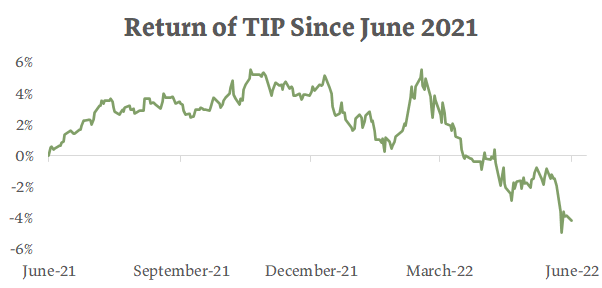
Here’s how that loss could have been avoided.
Besides inflation adjustments that increase their prices, TIPS also pay interest. This interest rate is a real yield because it’s how much the bond will return net of inflation. So a real yield of 1% means you will earn 1% above future inflation — but only if you hold the bond to maturity.
In the short-term, TIPS prices move opposite to yields. TIPS trailed inflation in 2022 because price declines due to rising rates exceeded inflation adjustments.
TIPS funds have different sensitivities to changing yields. Duration measures this and ranges from 3 for funds that own short-term bonds (like VTIP) to 20 for long-term funds (like LTPZ). For VTIP, short-term returns are more linked to inflation and less to yield changes.
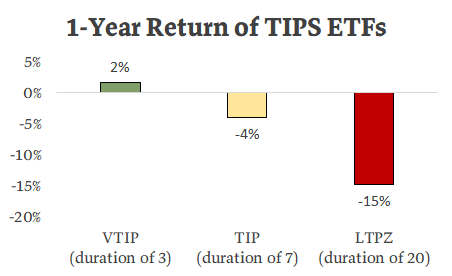
In 2018, Vanguard found that short-term TIPS are more correlated to unexpected inflation. This aligns with performance in 2022.
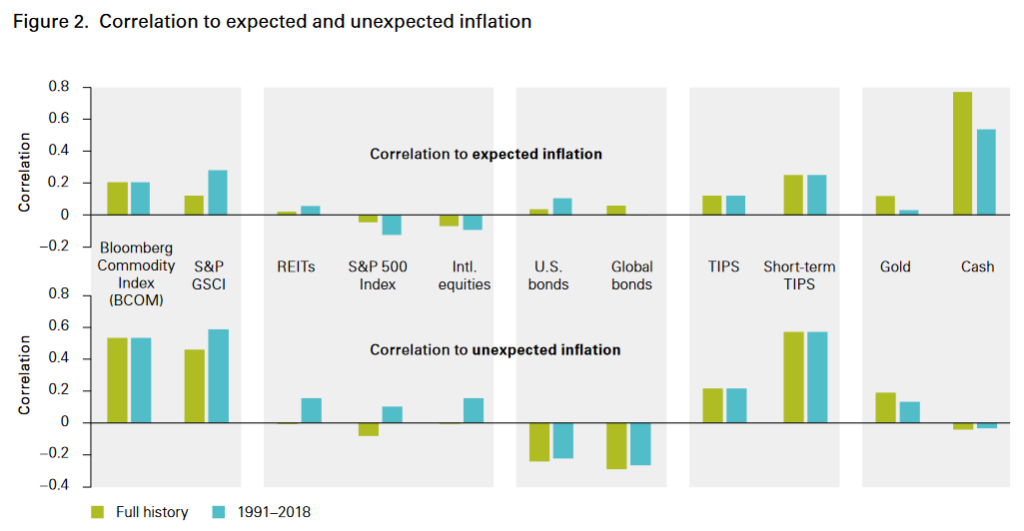
Future Outlook for TIPS
Rising real yields hurt short-term returns but benefit long-term investors. TIPS now offer more inflation upside despite the increase in inflation fears.
A 5-year TIPS bought today will return future inflation plus 0.36% per year, based on Friday’s market close. Compared that to last June’s yield of inflation minus 1.6% per year.
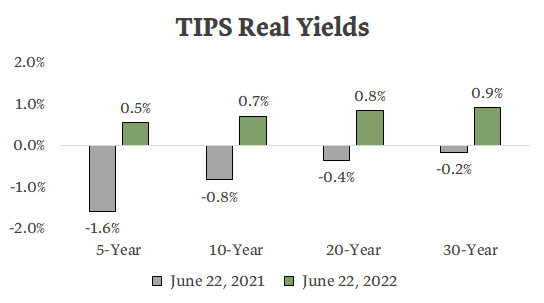
Tighter correlation to unexpected inflation is the main reason I prefer short-term TIPS, but they’re not without downsides. Long-term TIPS offer higher yields and lower breakeven rates. For example, the 5-year breakeven is 2.8% and the 30-year breakeven is 2.5%. This means there’s a higher inflation hurdle for short-term TIPS to outperform regular short-term bonds.
Retirees taking withdrawals are vulnerable to a long-term TIPS fund experiencing a bad sequence of returns like in 2022. This is another advantage of short-term TIPS: their lower volatility can decrease sequence risk and increase the odds of a sustainable retirement.
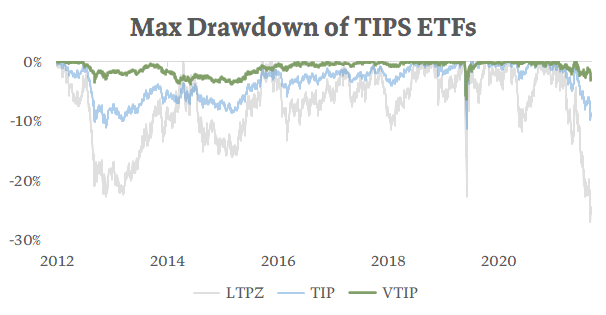
Passive Investors Need Inflation Protection
Nobody knows if inflation will keep rising. Expert predictions are often inaccurate, so I don’t have conviction in anyone’s ability to forecast inflation.
Even though inflation is unpredictable, investors should prepare for it. Yet TIPS are often missing from bond portfolios I review.
Passive bond funds tracking Bloomberg’s U.S. Aggregate Bond Index, including Vanguard’s $286 billion total bond fund, exclude TIPS. Now down 13% from its highs, the index is in its largest ever drawdown. TIPS could have helped.
I hope the next decade doesn’t evolve like the inflationary 1970s. But if it does, investors should consider investments correlated to unexpected inflation like short-term TIPS.
Summary
- Rising yields hurt TIPS prices. Short-term funds are less affected by yield changes and more correlated to inflation.
- Many passive bond funds exclude inflation-protected bonds.
- Higher real yields make today a great time to consider TIPS.
P.S. Want a deeper dive on TIPS? I wrote a 5-part series on them.
About Adam Collins
Adam Collins is a flat fee investment advisor. Through his company Eversight Wealth, he helps people build diversified portfolios, create a financial plan, and save money with a flat advisory fee. Eversight manages $75 million for 35 clients in 13 states and offers free consultations. Here are links to more info on their services and about Adam.
* * *
Feel free to post comments or questions below. If it is your first-ever comment, it will have to wait for moderation. After that, your comments will automatically appear.
David Enna is a financial journalist, not a financial adviser. He is not selling or profiting from any investment discussed. The investments he discusses can purchased through the Treasury or other providers without fees, commissions or carrying charges. Please do your own research before investing.

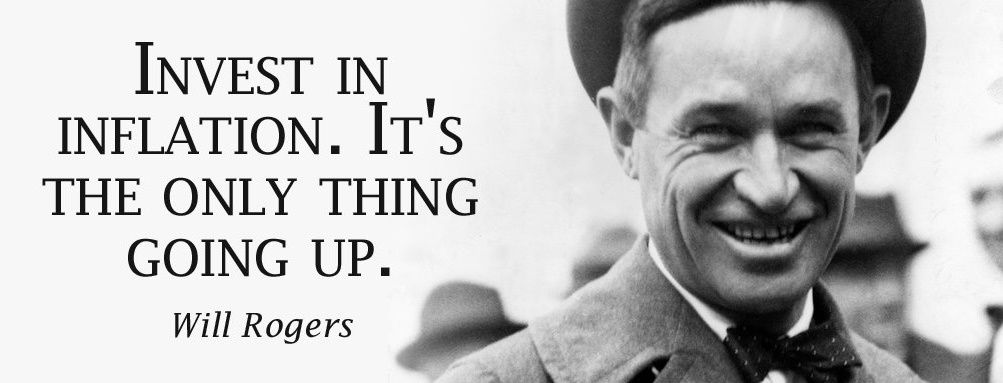

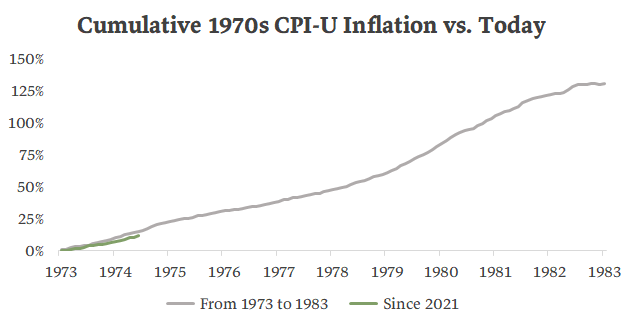
I don’t understand the term “expected inflation”. Is that just the current inflation rate – as published by the Bureau of Labor Statistics? Or someone’s prediction of future ‘expected’ inflation? I don’t see how TIPS (or anything) can be correlated to something that no one can predict, and varies wildly by different financial research institutions.
Expected inflation can be defined the rate of inflation expected by investors. That can be measured by the inflation breakeven rate, the difference between a nominal Treasury and a real-yield TIPS of the same term. For example, five years ago, a 10-year nominal Treasury was yielding 2.37% and a 10-year TIPS had a real yield of 0.62%, so the inflation breakeven rate was 1.75%. That was the average annual inflation investors were expecting from 2017 to 2027. Now, instead, we have 8.6% annual inflation. That is a huge example of unexpected inflation.
Thanks. So the CPI is past inflation (delayed by 5-6 weeks), and the breakeven inflation is the expected inflation in the future – as ‘expected’ by the “Market”. Then the 10 year expected inflation is calculated by the breakeven inflation rate from the 10 year nominal and TIPS real yield. The 5 year expected inflation is calculated by the same, but using the 5 year nominal and TIPS real yield. etc… Makes sense. Would be interesting to make an expected inflation curve – using the 5, 10, & 30 year new issue TIPS, and fill it in with secondary market rates. In my copious spare time, I’ll have to do that :).
Of course, I have noted many times that the inflation breakeven rate only measures market sentiment and is a lousy predictor of future inflation. An example from 2017: https://seekingalpha.com/article/4086587-tips-inflation-break-even-rate-accurately-predict-future-inflation
With high inflation and at least the prospect of longer-term inflation, it is confusing that TIPS have been falling in value 2022.
Apparently, the small coupon, and related long duration, has such a big impact on the market price of TIPS. TIPS are acting like regular long-term treasury bonds, falling in value as rates increase.
If the bond bull market is over, and inflation becomes more regular, I would hope TIPS’ real inflation protection, becomes more valued, and TIPS will not be priced solely on their duration and small coupons.
One issue could be, if inflation does become real, the fixed rate on TIPS could increase, making existing TIPS less valuable.
People often think that if inflation surges, TIPS will go up in “value,” but that isn’t true. They will have a higher nominal yield because of high inflation, but the underlying value of the TIPS will decline if real interest rates rise, as they have in 2022. As real yields rise, TIPS become more attractive as a new investment, even if the older TIPS are declining in value. My philosophy is to buy TIPS and hold them to maturity, and at this point TIPS are getting attractive as a new investment.
Yes obviously I understand that is how it has worked for the past decades as inflation has several times been zero or below.
I purchased 100K VTAPX summer 2021.
To date I am down close to $2800.
I will hold to maturity and evaluate then if I will
stick with my VTAPX holding, or sell and move the funds elsewhere.
Strange times these past two years and four months.
I’m seeing on Vanguard a total return of positive .97% YOY as of 6/30/22. Perhaps you are looking only at price YOY?
Admittedly I am not financially savvy to say the least. I do know I bought 100k of VTAPX, and my most current Vanguard statement shows I have VTAPX balance which is close to $2800 less than the $100K I used to purchase the fund last summer.
I agree with @BondGuy that this is odd. What month is your “most recent” statement, and what month did you make the purchase? Even playing around with the start/end dates on Portfolio Visualizer to make it as bad as possible, I can’t get a number that low to appear.
Two questions:
Did you turn off dividend reinvestment for the fund?
Did you buy VTAPX through a non-Vanguard broker that charges a fee?
If the answer to the first is “yes”, then that likely explains it. And possibly that holds for the second question.
If both of those are “no”, then my only guess is that it’s a weird one- or two-day anomaly based on how distributions are handled 06/29 was the record date, 06/30 the reinvest date, and 07/01 the payable date for the most recent dividend/distribution. If so, the number should correct shortly.
Is it possible you are not reinvesting dividends in that fund?
Looked at my dividend reinvestment selections. VTAPX now set to reinvest. Reviewed all my other funds to ensure dividend reinvest was set as intended. Thank you one and all for the heads-up.
How can you tell when TIPS ETF’s are trading at a real positive or negative return? VTIP shows -1 percent right now. The others don’t display the real return at all. Seems like this would be important to know when to buy them or not?
I have the same problem with Vanguard’s TIPS funds, because they give the 30 day SEC yield, which I would have thought is the same thing as the real yield, but it couldn’t be, because when I go to Bloomberg, and look at the TIPS yield with the same average duration, the yield is positive. Maybe TIPSWATCHER can explain???
Jim, this is an issue throughout the TIPS fund world. Vanguard tends to quote very conservative yields. For VTIP, for example, it is showing an SEC 30-day yield of -1.32%. Now look at STIP, from iShares with essentially identical holdings. iShares says the 30-day SEC yield is 7.59%. Well, wow, that is a big difference! In reality, the return on both these funds is very similar, but the way they report the 30-day yield is wildly different. Not good. I like the fact that Vanguard is conservative.
If you look at YTD total return, STIP is -1.39% and VTIP is -1.37%. These are essentially identical funds.
Thank you Bob and Tipswatch. It does seem like the wild west with how they report it. I went to bloomberg and could find the yields for 5,10,20, and 30. Bob you mentioned you were able to compare yields to VTIP. Is there a 2 year TIPS yield somewhere I am missing. If you could share the link that would be great. I agree if the duration of VTIP is 2 years and we can find publicized real rates for a 2 year TIP then we can feel good about what we are getting into with the fund. Although we of course have to assume the efficient market hypothesis that the fund is priced right, but since we are talking bonds here this may be a relatively safe assumption?
Hey Jim, I check current real yields for the major TIPS maturities (5yr, 10yr, etc) on FRED: https://fred.stlouisfed.org/categories/82. This also shows historical data in a useful graph
For shorter-term TIPS with maturities less than 5 years, I use the WSJ: https://www.wsj.com/market-data/bonds/tips. For example, VTIP has an average maturity of 2.5 years. The closest TIPS to that average maturity is the January 2025 bond, and today it has a real yield of -0.05%. That is a fair ballpark for what someone can expect to earn net of inflation if they hold VTIP for its duration
I have really enjoyed reading through the comments on this article, and I have been fascinated by the cash vs. TIPS back and forth. My thinking on this is :
— CASH means very safe investments that will mature in less than one year — money market funds, short-term Treasurys, savings accounts, short-term bank CDs. Think “emergency fund.” Even I Bonds would technically qualify, since they can be redeemed after 12 months (don’t do this!)
In recent years, cash has been paying near zero point zero, but I still held cash because I’m retired and I have to pay bills. Now, as several readers have pointed out, yields on these cash investments are improving to maybe 1.5% to 2%, totally safe. I recently moved money out of a bank account paying 1% to staggered 13-week Treasurys, paying 1.75% right now but likely to increase throughout 2022 and into 2023. So I can ride the yield increases higher.
— TIPS can be approached three ways: 1) a buy and hold to maturity investment, a very safe strategy; 2) a trading vehicle looking for capital gains, which increases the risks; or 3) an investment in a TIPS fund that smooths out the process but also brings in some interest-rate risks.
I don’t trade individual TIPS, ever. I am always buying individual TIPS to hold them to maturity. I do own TIPS funds, specifically VTIP and SCHP, with the weighting about 10x higher in VTIP. I want this investment to track inflation higher, without needless duration risk.
I really liked Adam Collins’s perspective in this article because he recognized and explained two things very well: 1) short-term TIPS funds are more correlated to unexpectedly high inflation, without needless duration risk, and 2) all TIPS funds are becoming more attractive even as the net-asset-values are falling. Real yields are becoming realistic again. They can go higher, sure, but we have entered the low end of a realistic range now. TIPS are looking much better: Their prices are more attractive even while inflation is much more scary.
Well, the yields are collapsing in July.
For a while, the 5 year was around +0.17%.
The 10 year is currently +0.52%.
I was looking forward to the upcoming July auction.
Now, things are starting to look dicey again.
We’ll see what happens with the next inflation report.
I think I may go for a 20Y in mid July in secondary market. Seems to be the sweet spot now.
It’s funny because I’ve been thinking the 6-month paying 2.52% looks like the sweet spot, but obviously as a cash substitute, not a long-term investment. The 20-year at 3.35% is still just under the EE Bond’s return of 3.5% if held for 20 years.
Yields are moving wildly right now, so a lot can change before that July 21 auction.
Just a simple question, but my Vanguard VAIPX fund in my IRA pays dividends, that are reinvested.
I assumed that even though the fund lost value, it would increase in my particular case when dividends are paid, which are based on inflation. So this year the dividends should exceed past years. So I am expecting to see an offset to the fund decrease in value, over the rest of the year, due to dividend payouts.
Am I missing something?
You’ve got it right. VAIPX distributions are increasing along with inflation. Since inflation in 2022 has been higher than in the past, you can realistically expect VAIPX to distribute more income. This will help offset the YTD loss in the fund’s price. VAIPX’s next distribution will actually be paid next Friday!
I thought, perhaps mistakenly, that the price of VAIPX will go down by the same amount as the distribution, meaning that the total value of your holding is the same?
It’s true that net asset value should decline with the dividend payout, and that’s why it is important to track the total return of a TIPS fund and not the net asset value. Here are payouts in June for the TIP ETF over the last 5 years, showing the much higher dividend in June 2022, based on inflation accruals + coupon payments, with inflation accruals being the key to the higher dividend rate.
June 1 2022 — 1.367 Dividend
June 1 2021 — 0.833 Dividend
June 1 2020 — 0.000 Dividend (deflation in April 2020)
June 3 2019 — 0.639 Dividend
June 1 2018 — 0.336 Dividend
If the decline in price caused by a VAIPX distribution is commensurate with the amount of the distribution, then how is the total return increased? My quick search of the Internet reveals site after site indicating that, because of this ‘cancelling out,’ a distribution from a mutual fund provides no real benefit to the account holder. Please tell me what I’m missing here.
What you are missing is the inflation-adjusted distributions. The distributions come from the inflation adjustments + coupon interest and they are paid out regularly (in this fund’s case, quarterly). VAIPX has a total return of -8.6% year to date. Its net asset value started the year at $28.12 and now is at $25.08, a decline of $10.8%. Net asset value won’t give you a true picture of performance. There has been only one distribution this year, on March 11 (31 cents). Another distribution should be coming next week, or possibly today, and it is likely to be higher. Net asset value + distributions = total return.
TIPSWATCH, I’m confused. What I am seeing this morning on my VTAPX holding does not appear to be consistent with what you are saying here. My reinvested dividend gave me a few more shares, but the total value of the holding is the same. (Note; VTIP had a tiny dip yesterday, so we can ignore the effect of the market change in value)
Note, please delete or ignore my longer post of about 20 min ago – which was misstated in part with regard to this issue.
Oooops, never mind my last post…I get it. Price went down, value is the same.
Exactly
David,
What BondGuy and you seem to be saying is that the benefit to the account holder is that s/he gets additional shares. But that seems to be a benefit only if the share price increases, while it seems to be bad news if the share price decreases. And the price of the VAIPX has been on a fairly straight march downward since the first of the year, from $28.33 on January 3 to $25.08 yesterday. So if the price keeps going down for more months, then that’s not only more losses from the drop in price, but further losses because of the greater number of shares owned. Once again, please tell me what I’m missing.
All that aside, I very much appreciate all you do with your blog, and your willingness to promptly reply to posters. And I can’t thank you enough for altering me, and everyone else, to the gold mine of the recent five-year TIPS resale.
Brian
Actually, the point I have been trying to drive home is that with these TIPS funds, especially, you have to look at total return and not the net asset value of the fund. Net asset value is the price you see quoted each day. That doesn’t reflect the total return. However, looking at your account balance does show your total return. When a dividend is paid, the net asset value goes down and the account balance stays the same. Over time, your account balance reflects your total return, not net asset value.
David,
I think you’ve led me to what I’ve been missing. I’m going to share it with everyone, as I think it’s important. This will be my last post on this subject, unless someone specifically asks me to respond to something.
When the Fed made it clear that it was serious about aggressively raising rates a few months ago, I did lots of research on the effect that such actions have on mutual bond funds. My understanding is that if the rate rises are steep and don’t come down to their original level for a long time, it can still be a wise move to stay in the bond fund if your time horizon is long enough. Although the price goes down as the rates go up, distributions will enable you to pick up more shares at lower prices. Therefore, your successive distributions will increase, allowing you to pick up still more shares, and so on. And if the price is going down, then the yields will be higher, and therefore the distributions will be even higher.
I think that David’s point is that with inflation-protected (I-P) bond funds, the distributions are particularly high, and thus the benefits of sticking with the fund are greater than with typical bond funds. Also, perhaps the screwy way that yields work with I-P funds may be a further advantage in this connection. In any event, while the price on the VAIPX has come down rather steadily since the beginning of the year, the yield, naturally, has done the opposite: from -1.68 to -0.23.
I hope everyone has a great holiday weekend.
Brian
My takeaway from this is (if it suits your age): “Buy Individual TIPS and hold them to duration. Don’t buy TIPS funds.”
The takehome from my perspective was…if the primary goal is to protect against unexpected high future inflation, stick with short duration TIPS or TIPS funds. decreased sequence of return risk, as compared to longer duration bonds/bond funds, is an added bonus.
DW is correct, that’s more the point I was trying to convey
Regarding individual TIPS, my comment response to 5Flavors expands on the use cases for individual TIPS vs. TIPS funds. I don’t view one as better than the other, just different tools for different financial needs
Great articles — I read all 5 in your series. Very helpful! Just curious, what do you think of the WIP ETF? I think inflation is going to be even worse in other countries than in the USA. WIP has been hit much harder than TIP, down nearly 20% last I checked. Note, I already have 80% of my bond money in VIPSX, so I’m well covered there.
Thanks for the positive feedback! Much appreciated
Regarding WIP, I personally do not use it. Mainly because it is hedging for a risk my clients are not exposed to: international inflation. For example, WIP’s top holding is UK inflation-linked bonds. These are appropriate if you’re a UK resident where future purchasing power is eroded by UK inflation. But for a US resident more concerned about the future value of their dollars, I think TIPS are a better solution since they’re tethered to US inflation
Two other negatives of WIP are its interest rate risk and its fee. Like this article mentioned, longer-term inflation-linked bonds are less correlated to unexpected inflation. And a 50 basis point fee can really add up over the long run (especially for a low-return fixed income fund)
So how does this compare with buying 10 year tips at auction in an IRA or Roth?
I think they’re just different use cases. For example, if someone needed to withdraw $50k per year from their IRA for the next 10 years, buying individual TIPS and holding them to maturity is a great way to do that. It’s matching together the portfolio’s expected outflows with guaranteed low-risk inflows
But then let’s say someone owned bonds to lower their portfolio’s volatility to a tolerable level and has no need for withdrawals. In that case, a short-term TIPS fund is maybe more relevant because it’s maintaining the TIPS exposure for you without the complexity of buying (and maintaining) a ladder of individual bonds. Continuously rolling a ladder of 5-year TIPS is essentially what Vanguard is doing with VTIP, and I would prefer to pay them 4 basis points rather than doing it myself
thank you- makes sense.
I planned to use ibonds for the second use case, remember when you could buy 60K/year, but lately they are paying so much that I can’t bear to cash the non zero ones in. I’ve felt like a 70’s loony for years with my inflation protection portfolio slice (and I lost out on capital appreciation) but those lessons from when I got out of college drove the damage inflation can do home..
Thank you for the education.
This is a very useful article. Of course, if you were to compare TIPs of like duration to regular Treasuries, the TIPS still outperform. For a safe investment, either bonds or cash would have performed much worse. This is worth explaining.
Thank you Elliot! I really appreciate it.
And for sure, TIPS are outperforming similar duration Treasury funds in 2022. That outperformance is even higher when comparing TIPS to funds with corporate bonds, since taking credit risk has not paid off this year. Tried to weave that into the end of the post by mentioning the abysmal recent performance of a regular bond fund.
Certainly glad I own some TIPS!
Agree on traditional bonds (of the same duration, as you said). However, cash has outperformed just about everything so far this year, short-term TIPS ETFs included. Direct from Vanguard’s site, VMFXX (their money market fund) has returned 0.14% YTD through 06/24. Compare that to VTIP (short-term TIPS ETF), and the value is -0.88%. Both numbers are total returns and in nominal numbers, and the numbers will be even more in VMFXX’s favor after today’s results are included.
For comparison, my own savings account has had a APY of 0.5% for Jan-Apr, 0.6% for May, and 0.8% for June. That’s a 0.27% total return through 06/24.
Interest rates have gone up faster relative to market expectations than even inflation has, thus the loss on even short-duration TIPS funds. I have heard/read so many people comment on their stock- and bond-fund losses this year that “At least I haven’t been watching my cash lose value to inflation.” They seem to be forgetting that their funds are losing to inflation just as much! In a rapidly rising-interest-rate environment (which is often brought on by inflation), cash is actually a decent hedge, and this is pointed out in more detail by Morningstar’s John Rekenthaler in a recent article he wrote.
All I know is that the I Bonds my wife and I bought in Oct, Jan, and Apr are all looking like stellar choices given they don’t have conventional interest-rate risk!
Cash is a great thing to have when both stocks and bonds are plummeting, as we have seen this year. In your case, you have an excellent money market account that should track the 4-week Treasury, and with a yield that should continue to rise in the next months. But after that, now that the bond market has readjusted with higher yields, the money market fund could lag. Can it really keep up with future inflation, if inflation is running at 5%? I Bonds have been the home run investment of 2022. Very safe, and a solid return based on past inflation, and will match future inflation.
This is a really interesting question that I think actually needs some serious consideration.
The Fed appears to be trying to fight inflation mostly through increases in the Federal Funds Rate currently. If that holds and inflation is more persistent than expected, short-term borrowing rates very much could end up becoming significant and outpacing inflation long term. I am of a different age than I believe most posters here are, being too young to have experienced the inflation of the 70s/early 80s but old enough to remember the years that followed. And when I was a kid, savings accounts returned well over inflation. To confirm that’s not just an errant memory, I used Portfolio Visualizer to run cash from the start of 1988 to the end of 2000…the inflation-adjusted CAGR was 2.22%. If that’s the era we’re headed back to (a big if), the rapidly increasing rates will indeed make savings accounts a better option than TIPS for a while.
Over the long term, that would, of course, be very good for TIPS and I Bond investors. The early I Bonds’ very high flat rates are a product of that era. And I still view the May-Oct 2000 I Bonds as one of the best investment options ever…it’s flat rate was 3.60%, so approximately the real return for those I Bonds. A 100% stock portfolio split 50/50 domestic/international has only returned ~3.05% real during that time!
Real yields on cash are negative sharply negative, even now. The 5Y TIPS is positive .44. I don’t see how cash makes a lot of sense beyond very short term needs.
What I quoted wasn’t about moving forward though, it was about the past. Here was the quote:
I was pointing out that the quote was factually incorrect. That is all. And while VMFXX is a very good money market fund (though my savings account has done better this year), even money under the mattress has outperformed VTIP this year. I have repeatedly seen people complain about their cash losing value to inflation this year, so they’re glad to be invested in stock/bond funds…it’s a mental error where they’re not applying inflationary losses to the funds too, and I want to call it out.
Full disclosure: my cash holdings are ~3% of my liquid assets, and they are a much smaller % of my total assets once non-liquid things are included. So I’m not hoarding cash. My personal investment “strategy” is buy and hold with diversified index funds and sticking with my asset allocation…no market timing, basically a boglehead. Thus, I’m not playing the game of what to choose to invest in when with the exception of I Bonds, which aren’t marketable securities and thus can have above-market expected returns at times.
HOWEVER, cash DOES make sense for market timers who believe that the market has underestimated rate increases (both real and nominal), as rising interest rates will hurt bond prices. This is easily demonstrable using VTIP and 5-yr yields. The 5-yr TIPS first became positive on 06/10, closing at 0.12% real yield. Despite that positive real yield, VTIP is down from closing at 50.88 on that day to being 50.25 as of this writing. Clearly, cash has beaten that 1.24% drop. And avoiding the fund to go with an individual 5-yr TIPS doesn’t get around that, as a cash market timer could buy a more-attractive 5-yr TIPS today than what was available on 06/10.
And this doesn’t have to be a very short-term phenomenon, as it’s lasted for 6 months this year already. It could last for several years. I’m certainly not banking on it and just sticking to my predetermined asset allocation. Market timing is just too close to gambling for me. But the possibility is very real.
“The 5-yr TIPS first became positive on 06/10, closing at 0.12% real yield. Despite that positive real yield, VTIP is down from closing at 50.88 on that day to being 50.25 as of this writing. Clearly, cash has beaten that 1.24% drop.”
To which I, were I a person who bought VTIP on 6/10, would say “so what?” because I still get the 0.12% plus CPI I bargained for on 6/10, provided I keep if for as long as the VTIP duration.
I’m a long-term buy-and-hold investor, so I completely get that sentiment.
But the market timer who waited until today to buy into VTIP would outperform you by a substantial margin. That may or may not continue to be true as we move into the future, no one knows. Cash could continue to pummel bonds, even TIPS, for years. Cash has significantly outperformed bonds for over a decade at times in the past. I’m not smart enough to predict it with certainty myself, so I’ll continue to stick with my asset allocation.
Let me ask this, do you believe the following quote to be correct:
If so, what evidence do you have? My post was about that, citing evidence showing it to be wrong. Current real yields of 0.44% are no guarantee that won’t happen again, and it could happen for years. Lots of people six months ago were saying cash “doesn’t make sense,” just like you did here. Only time will tell if that’s right. Just one more example of why I Bonds are a solid investment now even if the real yield of 5- and 10-yr TIPS are higher.
I don’t agree with the quoted statement.
I’m reinvesting my TIPS dividends, ergo, I must think that TIPS at today’s prices will outperform cash in the future. If I thought otherwise, I’d be putting them into my MM fund. But, sure, if the Fed raises the FF rate to 5%, 8%, 11%, who knows what, for sure cash will do better.